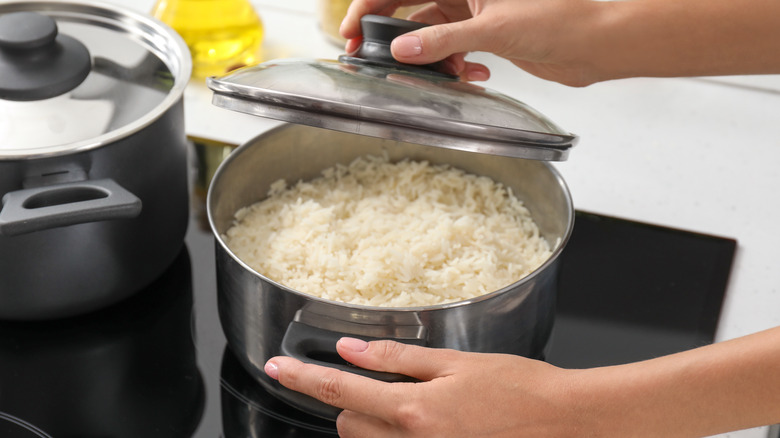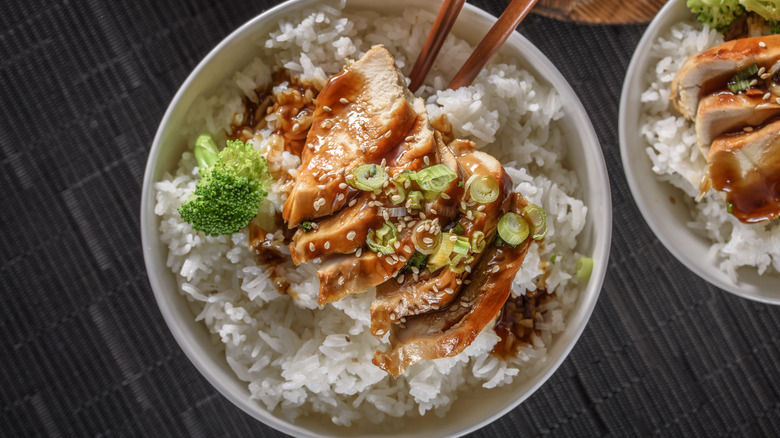Alton Brown Holds The Secret To Fluffier Stovetop Rice
Despite its apparent simplicity, cooking rice can often seem like a mystifying process. Everyone seems to have their own trick, resulting in a wealth of conflicting advice. What one cook swears by might lead to a mushy mess or undercooked disaster for another. Cooking legend Alton Brown has developed a stovetop method that consistently yields fluffy, perfectly cooked rice, all thanks to evaporation. After the rice cooks, Brown allows it to steam for a few minutes for ultra fluffy results.
A common myth involves the two-to-one water-to-rice ratio, but this is simply too much water. In fact, the stovetop method usually calls for nearly equal parts of rice and water. However, factors such as the recipe size, the type of rice used, and individual kitchen conditions can alter this ratio. The rice absorbs some of the water, and some is lost to evaporation. The amount of water that evaporates depends on variables such as pot size, burner heat, water temperature, and how well the lid fits.
How does Alton Brown make perfectly cooked rice?
For his "Rice in a Rush" recipe, Alton Brown suggests using 2 cups of long-grain white rice and 3 cups of water. Begin by filling an electric kettle with water. Over medium heat, melt butter in a saucepan until it just starts to brown. Add uncooked rice and salt to the pan and turn on the electric kettle. It will act as a timer for sautéing the rice. Stir constantly, and when the kettle clicks off, pour in the boiling water. Once the initial sputtering subsides, give the rice a stir, reduce the heat, cover, and let it cook for 20 minutes. After cutting the heat, allow it to steam for an additional five minutes before fluffing it with a fork.
This method results in fluffy, flavorful rice that's ready in no time. A viewer of Brown's "Pantry Raid: Rice Edition" YouTube episode expressed how this method revolutionized their rice preparation, saying, "After cooking rice for 25 years, and never getting it quite right, I have made it perfect every day now thanks to Alton. Thank you! I am appreciative every day, and my family is so grateful."
Why does Alton Brown's method work?
Adding boiling water to sautéed rice mitigates the variability in evaporation. The size of your flame, the size of your pan, and the temperature of your tap water all become less significant when adding hot water to a hot pan, so it's a more precise method and measurement.
Sautéing the rice kickstarts the cooking process and removes some starch, which helps the grains maintain their individuality. The toasted rice absorbs water more slowly, allowing it to cook evenly and maintain a pleasant texture. Each grain stands on its own, resulting in fluffiness. This technique of sautéing the rice in fat before adding water is prevalent in Middle Eastern and Mexican cooking, adding a rich, toasty flavor.
To ensure the success of this recipe, it is crucial to have a tight-fitting lid. Resist the urge to peek or stir during the cooking process. Stirring releases starch, which can turn your rice into a gloopy mess, and removing the lid allows the vital steam to escape. Finally, don't skip the fluffing step. Gently fluffing the rice with a fork releases trapped steam between the grains, preventing overcooking. As with any recipe, outcomes can slightly vary depending on the cook, kitchen, and materials used, but Alton Brown's rice recipe is an excellent starting point.



